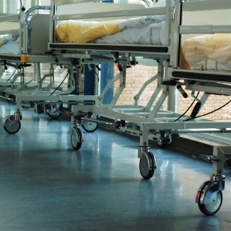Jul 16 2009
Scientists from UCL have created light-activated antimicrobial surfaces that could help fight the spread of hospital-acquired infections (HAIs). Professor Ivan Parkin (UCL Chemistry) and Professor Mike Wilson (UCL Eastman Dental Institute) have modified silicone with tiny amounts of commonly used dyes.
 beds in a hospital ward
beds in a hospital ward
The role of contaminated surfaces in the transmission of HAIs is an area of great scientific interest – particularly in the light of much publicised cases of infection due to methicillin-resistant Staphylococcus aureus (MRSA) and Clostridium difficile in UK hospitals.
Silicone – a polymer made from silicon, carbon, hydrogen, oxygen, and sometimes other chemical elements – is used in medical equipment such as catheters, but bacteria can colonise its surface and infections associated with catheter use are common.
Professor Parkin and Professor Wilson, working with colleagues in the UK and Spain, have developed a groundbreaking way to modify silicone so that it kills bacteria when exposed to light from a laser or from ordinary fluorescent lamps.
The process involves dipping the silicone in a solution where it bonds with organic dyes, then washing and drying it.
After a few minutes' exposure to light from a low power laser, the number of live bacteria on the surface of the silicone dramatically decreases.
When exposed to light the dyes generate highly reactive molecules - and it is these that are toxic to the bacteria.
Previous methods used to kill bacteria on the surface of catheters include using silver coatings – an expensive method – or flushing the catheters with antibiotics. However, using antibiotics persistently can make bacteria resistant to the drugs.
Professor Parkin said the antimicrobial surfaces had the potential to be used in a wide range of applications.
He said: “We are focusing our work on making polymers that could be used to reduce hospital-acquired infections – especially those arising from the use of catheters. However, the polymer films are transparent and could be used on a wide range of surfaces from bandages to keyboards and phones to door handles or flushes.”
Professor Wilson added: “Each year there are approximately 100,000 cases of hospital-acquired infection in England resulting in around 5,000 deaths, and the cost to the NHS may be as much as £1 billion a year.
“As many of these infections result from the use of catheters it is essential to develop new antimicrobial materials from which catheters can be fabricated in order to reduce the risk of an infection occurring. These novel light-activated antimicrobial polymers would be ideal for this purpose and have the added advantage that bacteria are very unlikely to develop resistance to them.
“As they are also activated by light from ordinary fluorescent lamps, they could also be used to coat surfaces thereby helping to reduce the number of pathogenic microbes in the hospital environment.”